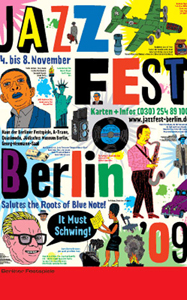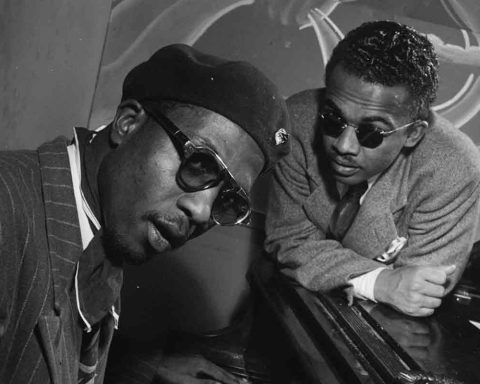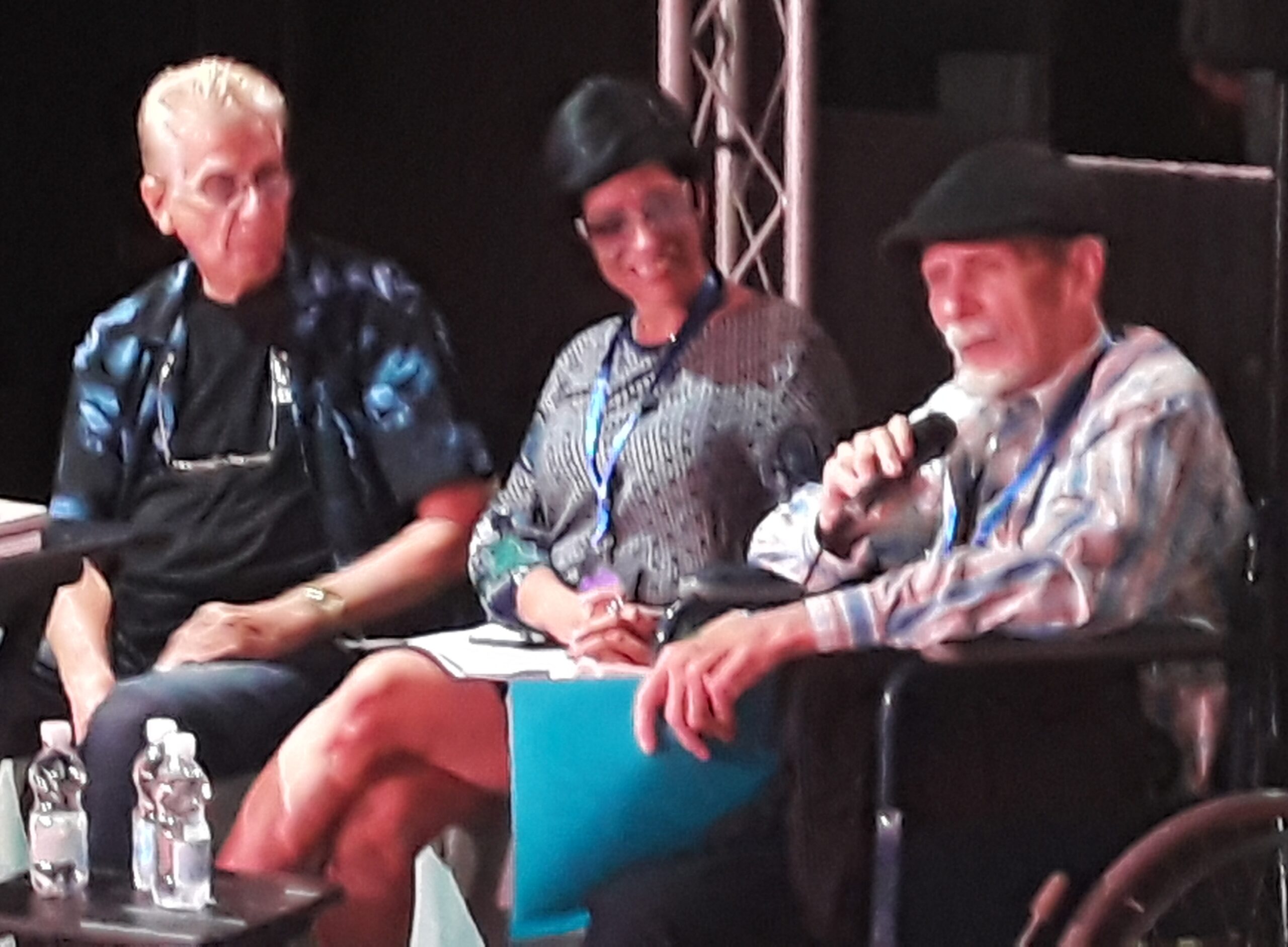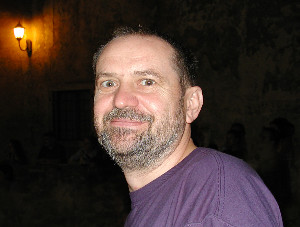
Except for one: Joachim-Ernst Berendt (1922–2000), the first artistic director, who started things off well in 1964 with a fine eye for detail, such as getting that year’s Nobel Peace Prize winner, Dr. Martin Luther King, Jr., to write a foreword for the program book, which remains the best one-page piece on jazz I’ve ever read. Berendt also had a good eye for the overall picture, featuring groups led by Europeans as well as Americans, and guest stars in an eccentric balance that often brought out the best in both, the known and the new, often on the same bills. The intent of such cross-pollination was always to stretch listeners’ palettes without causing panic sufficient to impede their openness in listening.
Berendt’s involvement with jazz extended far beyond the Berlin festival. He produced albums for MPS, the first great German jazz record label, as well as programs for SWF, one of Germany’s major radio networks, where he had co-founded the jazz department. His career evolved in a way that eventually put him on both sides of the table, which, in those relatively innocent times, wasn’t the problem it would be today, but all that caught up with him in Berlin, one of the toughest houses in the world, where booing is an art form. His last festival was in 1972.
Swiss pianist, composer and bandleader George Gruntz inherited Berendt’s open-minded pluralistic approach, and during prosperous times for what was then still West Berlin, expanded the scope of the festival to a more global approach, which suited him well. There were even more big-name stars, and now they became part of four-act, sometimes six-plus-hour evening concerts at Philharmonic Hall — endurance tests characterized by some as jazz’s equivalent to Wagner’s Ring cycle.
Gruntz was still in charge when the wall fell, and crosstown outreach began in earnest at once. In the early years this could be like going camping in the wilderness. It was more a matter of adding venues than anything else, and experimentation with new performance spaces continues today, all over town. Some work better than others, and to those venues, JazzFest still returns.
[pullquote]Though eastern-bloc musicians were a regular part of JazzFest from early on, none from East Germany played there until 1979. For some, it was their only opportunity to go to West Berlin.[/pullquote]
Though eastern-bloc musicians were a regular part of JazzFest from early on, none from East Germany played there until 1979. For some, it was their only opportunity to go to West Berlin, not that doing so was any easier for them than anyone else crossing the most gratuitously officious border in the world, where the regime of the east came closest to earning its moniker of German ‘Democratic’ Republic by practicing equal-opportunity bad manners toward all comers.
The first time I set foot on the stage of the Phil, to shoot a soundcheck, I met saxophonist Ernst-Ludwig “Luten” Petrowsky, an East Berliner, who was there — as were Albert Mangelsdorff, Evan Parker and George Lewis, among others — as part of Globe Unity Orchestra, Alex Von Schlippenbach’s changing-cast ensemble originally formed to perform there in 1966. Petrowsky was fretting about the gig running late enough that he wouldn’t be able to get home before the border crossings closed, which could be a serious problem, since his papers were only valid for that day. The other band on that bill was a Don Cherry and Jim Pepper one-off with Jabbo Smith, all of which proved to be an instructive welcome to JazzFest.
As the 1990s progressed, the economics of the festival changed faster than Gruntz’s adjustments toward a smaller budget. He was succeeded by trombonist Albert Mangelsdorff (1928–2005), whose stature in German jazz remains unique. Mangelsdorff started off on a high note in 1995 with JazzFest themed as “50 Years of German Jazz after WW II” featuring more homeboys more prominently than ever before. It was glorious, accomplished without shrinking the scope of the festival, rather accentuating the creative context in which it had been operating all along. Mangelsdorff was really the only person with the clout to pull this off, and it was done in style. His next five JazzFests were more pan-European, with plenty enough Americans included as well.
Swede Nils Landgren and Chicagoan John Corbett had, respectively, one-year directorships in 2001 and 2002. Landgren is mentioned below, and I regret having missed Corbett’s edition, which, logically enough, brought in some worthy Chicago artists, ranging from Von Freeman to Ken Vandermark, a good spectrum anywhere, including Berlin.
Peter Schulze’s 2003-2007 tenure saw intra-European bookings increase, most significantly from newly emerging nations and autonomous regions. Bringing people in from some of those areas could present logistical challenges, more often related to visas than to actual travel. But the show always went on. Schulze’s open ear (gained from years of directing innovative programming at Radio Bremen) brought in lots of new jazz-related sounds from many European musical cultures long suppressed or ignored. Schulze also paid attention to German stalwarts, presenting such combinations as Cologne’s WDR Big Band, arguably Germany’s best, with Joe Zawinul, which was virtually a levitating experience.
Present director Nils Landgren — like Mangelsdorff, a trombonist, and like Gruntz not a German — brought in a fine assortment of Scandinavian artists in 2001, including Lennart Aberg with a force-of-nature big band, and expatriate American pianist Steve Dobrogosz, who played a sterling solo set. Landgren’s lineups since assuming the helm on a longer-term basis for the 2008 festival have been more widely pan-European, with thoughtfully chosen American artists — fewer, yes, but of more consistent creative significance than at some points in the festival’s past.
All along, since earlier on in Gruntz’s tenure, every artistic director has enjoyed a consistency of quality thanks to the year-round diligence and good humor of Production Manager Ihno Von Hasselt, whose office’s ever-changing roster/schedule combines elements of an airport arrival-departure display, a Ouija board and a crossword puzzle. He has been the one who translates the directors’ lofty concepts into what is actually possible on the ground. Not an easy prospect, but it always gets done, and the high standards inherited from Berendt’s days still prevail.
The most significant change over the last 20 years has been the reduction of primary venue size. The 2000-plus seats of Philharmonic Hall have been succeeded by less than 1000 in the House of the Berliner Festspiele. Peripherals such as T-shirts and big fancy program books have also gone by the boards (though the festival did publish a substantial historical survey/program book for its 40th anniversary). As a distinguished member of the German critical community observed soon after reunification, Berliners were finally being made to realize how things had been all along in the rest of the west, where the music had always had to pay its own way.
West Berlin was as much a showcase for the NATO powers as East Berlin had been for the Warsaw Pact. But the West German government, sharing the costs with the city of West Berlin, subsidized its landlocked island of free enterprise unto a higher cultural level — JazzFest being only one of six officially sponsored festivals. Over in East Berlin, the annual Jazz Stages was a more modest affair. In the days of the wall, one advantage the musicians from the east had over those from the west was a guaranteed income, even if it was based on that chip-off-the-old-Bloc concept of ‘We pretend to work and they pretend to pay us.’ After reunification, this caught up with the East Germans, who had to adjust to a free-market, non-subsidized environment, while the West German jazzers had an easier time adapting to increased competition in a marketplace that had not expanded nearly so much as the number of practitioners seeking work within it. Fellow writers and photographers in Berlin assure me this was not unique to musicians, and some have adapted better than others. It is an ongoing process, with some ambivalence in all sectors. For more than a decade now, a bumper sticker I’ve seen on both sides of town reads “I want my wall back.”
JazzFest 2009 had some fine moments. It was possible, within 24 hours, to hear, on the same Bosendorfer grand, Hank Jones, in trio (Joe Lovano was booked to join him but had recently broken some bones in Barcelona) and Steve Kuhn, with a nice solo spot amid his accompaniment of Sheila Jordan, herself as lively and adventurous a storyteller as ever at 81. The strongest single concert was a double bill of Barry Guy’s New Orchestra, with Trevor Watts and Evan Parker holding forth from among the ranks, and Dave Holland’s Overtone Quartet, a band I’d put next to Wayne Shorter’s any day. JazzFest ended, as usual, on a Sunday, with Paolo Fresu leading his quintet, exploring Ornette tunes as well as originals at Quasimodo, a longtime institution among Berlin’s clubs.
Next evening was the 20th anniversary celebration of the wall coming down, with the official festivities centered at the Brandenburg Gate, in a cold rain uninviting enough that I chose to watch it all from a couple of kilometers away in the comfort of my hotel room, though the weather didn’t keep over 500,000 other folks away. The well-produced broadcast combined elements of the Rose Bowl parade, a presidential inauguration and a NASCAR race, all handled with more class than American TV would ever allow. The weak point of it all, alas, was the music, including nothing that could possibly have been mistaken for jazz, but, mercifully, there wasn’t much of it, either.





